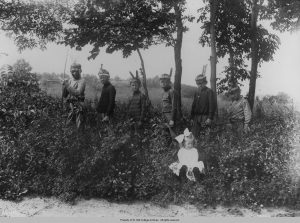Indigenous Feminisms and St. Olaf’s History of Denial
By Hanna Elstad
To look at feminism, it involves not just fighting for the rights of women, but for all groups. It’s like the idea that as long as one is oppressed, we all are oppressed. However, I had never considered the perspectives of indigenous peoples in regards to this.
I have defaulted to indigenous feminisms only as a subset of feminism, but that in itself minimizes and distorts their voices and intentions of their fight.
In the chapter, “Global Feminisms” in Feminism is for Everybody, bell hooks talks about how mainstream feminists tend to view sexism through the lens of white imperialism. She mentioned examples of how we view the United States as a shining example of a place where women have many rights/freedoms, and view “third world” countries or indigenous societies as more oppressive. Feminism comes in many different forms, not just the Western White Middle-Class variety.
Postcolonialism was something I had only ever thought about or discussed in relation to European colonization and the legacy that endures today. However, I think too often as an American, I forget that the land I live on was achieved through bloodshed and cruelty.
Frustratingly, St. Olaf sits on Dakota land and yet we never talk about or acknowledge that!!! Instead, the college perpetuates and puts forward a mythos/history of the college about how it was founded by brave, hardworking Norwegian immigrants who built a life out of the harsh Minnesota land… Um! Excuse me! There were people already here! What about them!? There were already people here when the immigrants got here… How much violence & bloodshed happened so that white settlers could live out this fantasy??? Most of us here don’t even realize this used to be Dakota reservation land! And, as an ignorant white student, I have been complicit in this.

Photograph of St. Olaf faculty children playing while dressed up as the stereotypical image of the “Indian”
Two years ago, my advisor helped host a national conference here about decolonizing German language education. Before even opening the conference, she acknowledged the fact that St. Olaf is on Dakota land, that they were “the original custodians of this land” and that we took it from them… Something like that only takes 30 seconds. Why don’t we do this at every college sponsored event? Why don’t we hear about this? Why don’t we talk with these tribes & work with them? Why doesn’t the college contribute money to groups that help this? Don’t invest money in corporations that are to this day still pushing indigenous peoples off their land!?
Looking around, I do not know of any students of indigenous descent. Back in the 70’s there was an effort led by Larry Martin, the Native American Affairs Coordinator for St. Olaf at the time, to make changes to the college structurally so that indigenous students could come to St. Olaf and thrive. He fought to create events educating the student body on the history of the tribes native to the Northfield area. Martin spoke with the various academic departments about topics and themes that were culturally insensitive to students of indegeous descent so that the curriculum was more inclusive. What happened to this work? Why did this stop? We aren’t doing anything to try and fix what we created.
Works Cited
Felland, O.G. Indians. 1905. St. Olaf College Shaw-Olson Center for College History, Northfield. St. Olaf College Archives, https://elevator.stolaf.edu/archives/asset/viewAsset/589267d5e758ae345c8cae6a.
Hooks, Bell. Feminism Is for Everybody : Passionate Politics. [Second edition] ed., Routledge, 2014.
Olaf, St. “History and Heritage.” – About St. Olaf, St. Olaf College, 11 Mar. 2020, wp.stolaf.edu/about/history/.
“St. O plans program to aid Indian education.” The Manitou Messenger, vol. 084, no. 12, 17 Sept. 1971, p.2, https://stolaf.eastview.com/browse/doc/45263809.Sulander, Mark. “Indians… And the St. Olaf Option.” The Manitou Messenger, vol. 091, no. 17, 13 April 1978, p.8, https://stolaf.eastview.com/browse/doc/45132247.